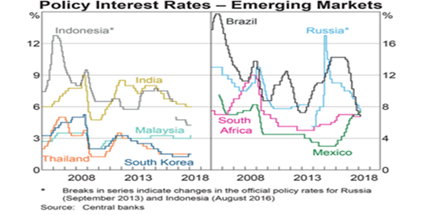By guest contributor Elaine Li, Analyst, Atchison Consultants
Unprecedented monetary policy stimulus over the past decade has resulted in interest rates falling significantly, to the extent interest rates are extremely low or even negative. 20% of government bonds in developed countries have negative yields as at March 2017. There has been an increasing trend of investors investing in emerging markets (EM) securities in a search for higher yields.
In 2017, EM debt securities generated a return of 13% on average, substantially outperforming developed market debt securities. The higher returns were generated from a combination of generally higher interest rates, higher credit premiums and appreciation in EM currencies.
- Nominal and Real Rates in EM
Compared with developed markets, EM generally have higher levels of interest rates. As shown in Chart 1 below, most emerging economies have interest rates at approximately 6.0% at the end of 2017.
Chart 1 – Policy Rates in Selected Emerging Economies from 2005 to 2018
In addition to high nominal interest rates, average inflation in EM has also been at a record low in 2017. Given high nominal interest rates and low inflation, EM debt securities generally offer higher real rates than that of developed markets.
- Credit Ratings in EM
Compared with developed markets, most emerging market debt is not rated as “investment grade”, resulting in higher credit-risk premium and higher yields. However, a positive characteristic of EM countries is they generally have lower debt-to-GDP ratios compared to developed countries. Average debt-to-GDP is above 100% in developed countries, compared with 50% in EM economies (2017). Given lower debt levels in EM, the spread per unit of leverage are materially higher on EM debt securities.

